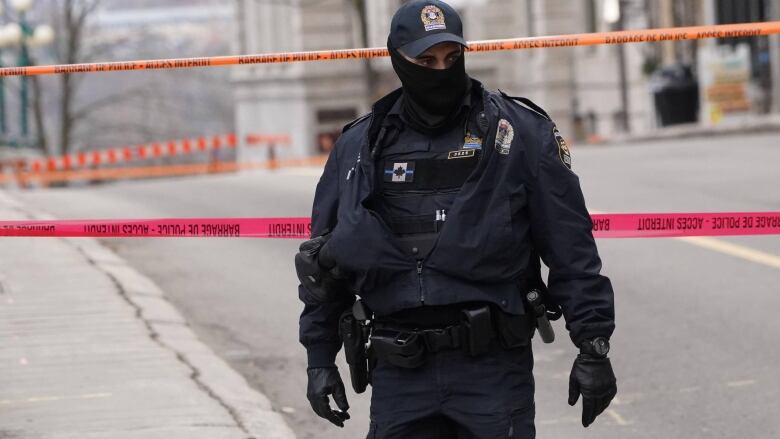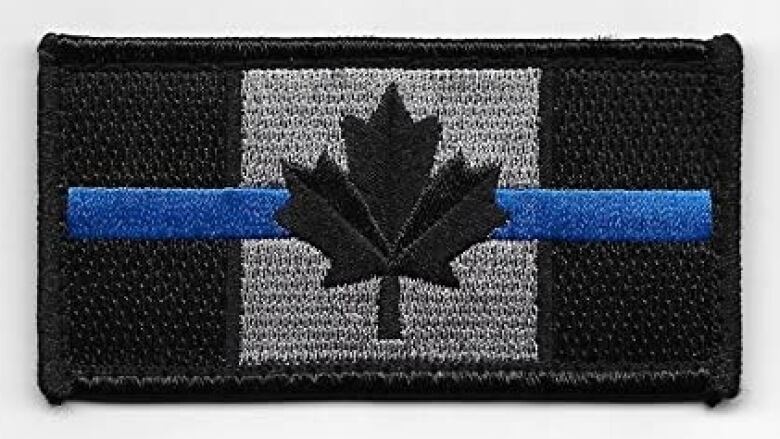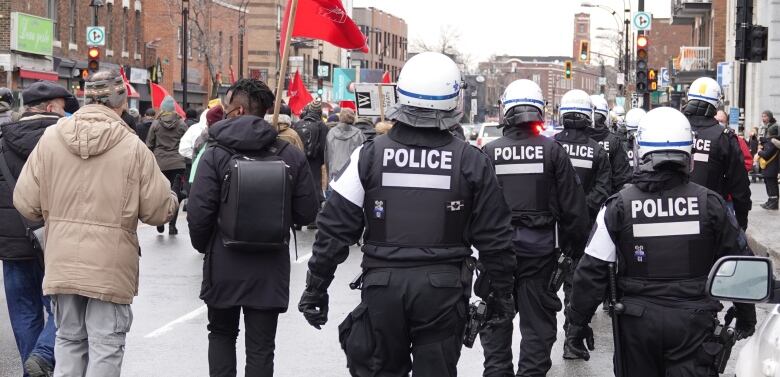Quebec City police force still 'tolerates' thin-blue-line patch
Civil rights activists argue symbol is provocative, divisive and wearing it breaks Quebec's own law

The thin blue line a symbol that's been banned by the RCMP and some municipal police forces is once again stirring up controversy in Quebec, after officers in Quebec City were seen wearing thepatches on their uniforms at recent protests against pandemic measures.
A spokesperson for the Service de Police de la Ville de Qubec (SPVQ) told CBC the image of a thin blue line running through a Canadian flag represents support for law enforcement and therole of police in protecting the public from criminals, and it commemorates officers who died on duty.
But many who have taken to the streets in support of the Black Lives Matter movement and other civil rights activistsdon't see the thin blue line that way.
"It seems over time it has been appropriated by certain extremist elements in society to convey something else," said Fo Niemi,director of Montreal'sCenter for Research Action on Race Relations (CRARR). "Therefore,it can become a very divisive symbol, especially vis--vis the very diverse population that we are."
"When a symbol is worn on the police uniform, one has to ask the question, is it an integral part of the police uniform? Is it a symbol of the police department of what police services should convey?" Niemi asked.
"Uniforms need to convey political neutrality and social cohesion."
Where to draw the line
In Montreal, officers assigned to a recent demonstration against pandemic measuresand a counter-protest in Jarry Park were also seen wearing thin-blue-line patches.
Jenny Cartwright, an artist, social activist and documentary filmmaker, tweeted several photos, circling the patches in pink ink.
MarlihanLopez, a Black feminist activist and a self-described police abolitionist, said she sees police wearingthe thin-blue-line symbol as an act of intimidation and provocation.
She takes issue withthe argument made bypolice brotherhoods in Quebec thatthe badge was aroundin the province beforethe rise of the Black Lives Matter movement in the U.S., and therefore can't be considered racist.

"State violence by police is something thatoccurred way before George Floyd," she said. "To accept these symbols for us is to normalize that state violence on our communities as it manifests through policing and surveillance."
Lopez sees a similaritybetween the thin-blue-line badge and the controversial red bands worn by some Sret du Qubec(SQ) officers in the wake of a sexual abuse scandal involving police in Val-d'Or, Que.,that rocked the province in 2015.
After six SQofficers weresuspended while allegations that they'd been involved in the sexual and physical assault of Indigenous women were investigated,some of their colleagues wore red arm bands emblazoned with the number of theVal-d'Or detachment.
Those arm bands, worn as a show of solidarity with the disgraced officers, are no different than the thin-blue-line patch, Lopez said.
"They're both symbols, for me, of complicity with white supremacy, complicity with state violence, complicity with sexual violence in the case of the SQ officers," she said.
CRARR calls for patch ban
The Montreal police servicesays it's currently reviewing all of its policies around officers' physical appearance and dress code, and it is seeking a ruling from its ethics committee as to whether its officers can wear symbols like the thin blue line.

The SPVQ, which said in a statement it has "tolerated" the symbol for a couple of years, declined CBC's request for an interview. A spokesperson for the municipality of Quebec City said neither its administration nor its diversity and inclusion officer would have any further comment beyond what the police service had said in its statement.
CRARR's Niemi says he believes Public Security Minister Genevive Guilbault should ban the thin-blue-line symbol right across the province.
"It seems the publicsecurity officials have tried to avoid or evade this issue," he said. "It does raise more questions about the message of political neutrality that police officers and their uniform should convey."
"And we should not underestimate that, because today they can wear the symbol and tomorrow, what other symbols will police be allowed to wear on their uniforms?"
What about Bill 133?
Niemi says by tolerating the wearing of the patch, public security authorities are ignoring Quebec's own law, which expressly forbids police in the province from modifyingtheir uniforms in any way.
The province adopted Bill 133 in 2017, to force officers to stop wearing colourful camouflage pants on the job as a pressure tactic in a protracted labour dispute. The law states officers must wear all of the equipment provided by their employer and cannot alter or substantially cover it.
Guilbault's office declinedCBC's request for an interview, writing in a short email that each police force in Quebec is responsible fordetermining and applying the dress code for theirofficers.
The Public Security Ministrydid not respond to follow-up questions asking who isresponsible for enforcing the provincial law on police uniforms and why police serviceswould beallowed to set their own rules on uniforms.












_(720p).jpg)


 OFFICIAL HD MUSIC VIDEO.jpg)
.jpg)



























































































